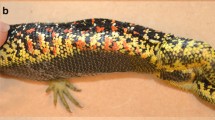Abstract
The behavior of two unicornfishes, Naso unicornis with a horn-shaped protuberance on the forehead and Naso vlamingii with a round protuberance, was observed in social and reproductive contexts in an aquarium. Males of both species performed displays that were associated with quick changes in the colors of the protuberance and other body parts, highlighting the protuberance by color contrast. The displays with color changes of the protuberance took place when a male courted a female in the evening or in the night. The same displays were occasionally performed by males toward females throughout the daylight hours. In N. vlamingii, dominant males displayed the protuberance toward subordinate smaller males. Although the sizes and shapes of the protuberance were sexually monomorphic, females of both species rarely made displays of the protuberance. A hypothesis about the function of the protuberance in unicornfishes is proposed: that males use the protuberance as a conspicuous signal in courtship and contests among males by emphasizing it with quick changes of its color contrasts. We argue that the combination of morphologically distinct protuberances and quick changes of their color is a sexually selected trait among unicornfishes, because these characters play important roles in intersexual and intrasexual interactions.
Similar content being viewed by others
References
M Andersson (1994) Sexual selection Princeton University Press Princeton, NJ
CRJ Boland MC Double GB Baker (2004) ArticleTitleAssortative mating by tail streamer length in red-tailed tropicbirds Phaethon rubricauda breeding in the Coral Sea Ibis 146 687–690 Occurrence Handle10.1111/j.1474-919x.2004.00310.x
WG Borden (1998) ArticleTitlePhylogeny of the unicornfishes (Naso, Acanthuridae) based on soft anatomy Copeia 1998 104–113 Occurrence Handle10.2307/1447705
N Burley (1981) The evolution of sexual indistinguishability RD Alexander DW Tinkle (Eds) Natural selection and social behavior; recent research and new theory Chiron New York 121–137
V Geist (1966) ArticleTitleThe evolution of horn-like organs Behaviour 27 175–213
JP Hailman (1977) Optical signals Indiana University Press Bloomington
JW Johnson (2002) ArticleTitleNaso mcdadei, a new species of unicornfish (Perciformes: Acanthuridae), with a review of the Naso tuberosus species complex Aust J Zool 50 293–311 Occurrence Handle10.1071/ZO01049
IL Jones FM Hunter (1999) ArticleTitleExperimental evidence for mutual inter- and intrasexual selection favouring a crested auklet ornament Anim Behav 57 521–528 Occurrence Handle10196041 Occurrence Handle10.1006/anbe.1998.1012
R Lande (1980) ArticleTitleSexual dimorphism, sexual selection, and adaptation in polygenic characters Evolution 34 292–305 Occurrence Handle10.2307/2407393
RF Myers (1989) Micronesian reef fishes Coral Graphics Barrigada
JE Randall (2002) Surgeonfishes of Hawaii and the world Mutual Publishing Hawaii
JLB Smith (1951) ArticleTitleSexual dimorphism in the genus Naso Lacepede 1802 with a description of a new species and new records Ann Mag Nat Hist 12 1126–1132
JLB Smith (1966) ArticleTitleFishes of the sub-family Nasinae with a synopsis of the Prionurinae Ichthyol Bull (Rhodes University, Grahamstown) 32 634–682
Author information
Authors and Affiliations
Corresponding author
About this article
Cite this article
Arai, H., Sato, T. Prominent ornaments and rapid color change: use of horns as a social and reproductive signal in unicornfish (Acanthuridae: Naso). Ichthyol Res 54, 49–54 (2007). https://doi.org/10.1007/s10228-006-0373-z
Received:
Revised:
Accepted:
Published:
Issue Date:
DOI: https://doi.org/10.1007/s10228-006-0373-z




